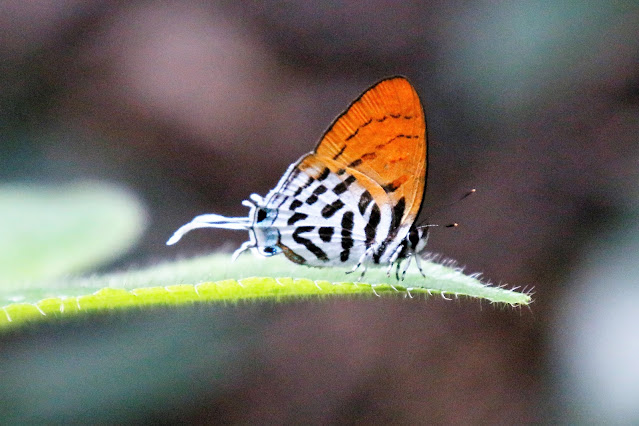A highly diversified insect life in an ecosystem is usually closely associated with a resourceful environment. In understanding the conservation and needs of any species, one actually need to understand their biological setup and intricate behavioral cues that may sustain the existence of the species. An understanding of the correlation of butterflies with their host plants as well as the wellbeing of the host plants are also critical in the conservation efforts of Lepidoptera. Their larva and adults at times occupy different habitats and requires different resources for their survival. For example the Indian Palm Bob (Suastus gremius gremius) oviposition host plant is "Phoenix acaulis" while its larva host plant are Coconut Palms and, Lady Palms (as well as Yellow Cane Palms and Sealing Wax Palms as discovered by SK Khew and his team from Singapore). Hence an increased in anthropogenic activities which results in habitat fragmentation and lost of host plants may effect the previously functional metapopulations.
The month of April saw the beginning of a transition of the monsoon phase which caused some heavy rain and thunderstorm in this region. The current monsoon transition phase marks the end of the northeast monsoon phase which started since last November. This new Southwest monsoon phase on the other hand is expected to continue until mid-May. I have managed to score a few nice and uncommon to rare butterflies in between those rain showers.
Whitespot Palmer (Eetion elia)
I was lucky to see this butterfly which is considered unique and uncommon.
It has no subspecies across its range.
It flew across the trail from right to left like 'Flash Gordon'. Luckily it landed on some palm leaves.
Initially it was a bit skittish but after awhile once it has calmed down I was able to approach it quite close.
Yellow-disc Tailless Oakblue (Arhopala perimuta regina)
It was last seen in January about 100 meters from the current location. Could it be the same one ?
The Red Spot Duke (Dophla evelina compta)
This butterfly is about the size of an Archduke. To snap its photo I had to find my way deeper into the foliage as it kept itself outside from the main trail.
Common Posy (Drupadia ravindra moorei)
This butterfly species has been quite common lately and they like to hang-out on hairy leaves.
The month of April seems to produced a number of sailers.
This neptis species I think is most likely a "Burmese Sailer" (Neptis leucoporus cresina)
Meanwhile this one above could be a "Colour Sergeant' (Athyma nefie subrata)
The above is most likely a "Malayan Sailor" (Neptis duyodana)
Knight (Lebadea martha malayana)
A fairly common butterfly but it is usually found only in forested areas.
Spotted Black Crow (Euploea crameri bremeri)
Sometimes you could see a few flying gently in the forest tree tops but this one has decided to fly lower.
Lesser Striped Black Crow (Euploea eyndhovii gardineri)
I believe this species is much less common than the earlier 'Black Spotted Crow'.
The above photo which was taken by my friend with a handphone is a "Ciliate Blue" (Anthene emolus goberus). So lucky to see its upperside. ID was informed by a Singaporean butterfly enthusiast.
A type of Jamides - most likely a "Common Cerulean" (Jamides celeno celeno)
Could the above be a "Pointed Line Blue" (Ionolyce helicon merguina)
The above skipper looks like a "Lesser Dart" (Pothanthus omaha omaha)
The above skipper could be a "Malayan Dartlet" (Oriens paragola pseudolus). It was based on its more / deeper orangey colors.
A very brightly coloured skipper indeed.
Neptis miah batara (Small Yellow Sailor)
This 'sailer' prefers to puddle on the ground as compared to other sailors. This time there were two of them.
Quite a scary looking face.
Could the above be a "Perak Laskar" (Pantoporia peraka peraka)
Blue Posy (Drupadia scaeva scaeva)
The above butterfly is just about the size of a 'Jamides' but is very skittish. Doesn't allow me to get a closer look. This shot was made from a distance.
Bifid Plushblue (Flos diardi capeta)
Never seen this one before.
Lesser Darkwing (Allotinus unicolor unicolor)
Could this be two different Lesser Darkwings?
Vagrant (Vagrans egista macromalayana) (Fruhstorfer)
Vagrant - this butterfly was once declared extinct in Singapore only for it to reappear after three decades later.
In Peninsular Malaysia, it is considered "moderately common" and can be found mainly in the forested regions.
One of the highlights of any nature trips, is the appearance of rare or uncommon butterflies.
Yellow Banded Awl (Hasora scoenherr chuza)
Like most skippers, this Yellow Banded Awl can fly very fast and its wing beats can be heard if it flies closer to your ears.
For every new and rare butterflies, my heart will jump for joy. That's the beauty of watching nature. The above is a "Blue Dandy" (Laringa castelnaui castelnaui). Described as one of the rare species by literature.
Spotted Plum Judy - Abisara geza niya (Fruhstorfer)
Gender: female
It took awhile for many of us to ID the above skipper until an expert finally nailed it as a worn out female "Fullstop Swift" (Caltoris cormasa).
The same "Fullstop Swift" with flash on. Still can't see any spots due to its worn out status.
This Yamfly (Loxura atymnus fuconis)has something peculiar above its eye. Not sure what was it though.
Indian Palm Bob (Suastus gremius gremius) (Fabricius)
Status: Fairly Common
Lastly here is an interesting moth which you might seldom seen.
Dog's Paw Moth (Plutodes malaysiana)
TO APPRECIATE NATURE YOU WILL NEED TO BE CLOSED WITH NATURE !




































































.JPG)